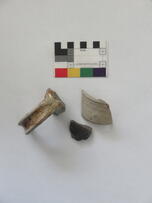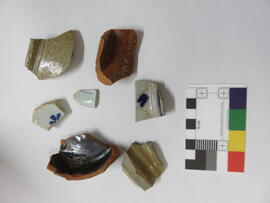Identity area
Reference code
Title
Date(s)
Level of description
Extent and medium
Context area
Archival history
Immediate source of acquisition or transfer
Content and structure area
Scope and content
A total of 627 sherds of pottery (12.7kg) were recovered during the recent investigations conducted at Jesus College. The following discussion of this assemblage has been divided into two sections; the first details the material that was recovered from stratified contexts, and the second the unstratified sherds that were recovered from Trenches 1 and 2.
A total of 359 sherds (7265g) were recovered from unstratified deposits encountered in Trenches 1 and 2. This represents 57.3% of the total assemblage by count, and 57.4% by weight. As Table 2 demonstrates, a very similar range of fabrics are represented as were recovered from the stratified deposits discussed above. No vessels of inherent significance were identified.
The range of material recovered, which was dominated by post- Medieval wares, is broadly typical of assemblages derived from the Cambridge region generally (see Edwards & Hall 1997). No vessels of inherent significance were identified, and the quantity of stratified material was relatively low. Nevertheless, the group is of some significance because to date only a small number of comparable assemblages have been recovered from secure collegiate contexts in Cambridge. In association with the assemblage recovered from the College Library excavations (Evans 1995b), it compliments the material that has previously been recovered from late 16th and early 17th deposits associated with Trinity College’s kitchens (Newman in prep.), from 16th century pits at Gonville & Caius College (Alexander 1995) and from an early 17th century pit group at Pembroke College (Hall 2002), and provides an important contrast with the much more extensive domestic assemblages that are known from the town.


























